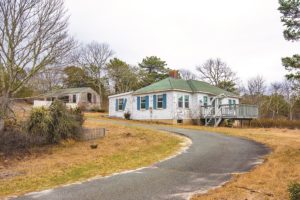PROVINCETOWN — For Outer Cape communities that have been relentlessly squeezed by the housing crisis, producing new housing has been a primary policy response. In particular, affordable housing developments — what’s sometimes called “big-A affordable housing,” (the word affordable has a precise legal meaning) — have been a centerpiece strategy.
One reason for this is that such projects can be surprisingly affordable for the towns themselves. A review of documents for four different projects — two that are complete, and two more that are in planning stages — shows that state and federal funds make up the lion’s share of the projects’ costs. Towns themselves generally contribute 10 percent or less of the total cost of these affordable housing units.
The town’s contribution usually takes the form of land, which is either sold cheaply or leased for 99 years to the project developer. Some projects involve a cash infusion of a half million dollars or so, typically in the form of a Community Preservation Act grant. The limiting factor for this kind of housing isn’t really money: it’s finding suitable land, experienced developers, and the time it takes to bring these projects to completion.
Province Landing, Nauset Green
The documents for two completed affordable housing developments show how the blend of funding sources works. Province Landing in Provincetown was built on 2.6 acres that the town acquired from Cumberland Farms for $1 million. All 50 apartments are for people making less than 80 percent of Area Median Income (AMI) — currently, 80 percent is $62,200 per year for a two-person household, or $54,450 for one person.
Provincetown didn’t directly contribute to the project beyond purchasing the land. Most of the funding came from a complex array of state and federal tax credits for the development of big-A affordable housing. The Community Builders of Boston, developer of the project, did take out a 20-year mortgage, but only for $4.5 million, a third of the total project cost.
Rents are controlled rents on the 50 apartments, but are enough to cover that mortgage, the operating and maintenance costs, and a modest profit, the documents show. After that, the mortgage will be paid off, and the developer will earn a steady return for the rest of the 99-year lease. Because of the state and federal money, the town’s contribution comes to $20,000 per apartment.
Nauset Green in Eastham shows the same pattern. The 65 apartments there cost $23 million total, but the town contributed just $1.8 million in the form of land and cash. Wellfleet and Orleans each kicked in $100,000. The direct municipal contributions come out to about $31,000 per apartment, and they have to be rented at controlled rates for 99 years.
Cloverleaf and VFW
The Cloverleaf project in Truro works out to be even cheaper for the town, because the land was free. The 3.9 acres on Highland Road at Route 6 had been reserved by the state Dept. of Transportation for an interchange that was never built; they were transferred to Truro specifically for construction of affordable housing. The $12.1-million bid to build the project, from Community Housing Resource Inc. of Provincetown, includes a $480,000 contribution from the town.
The exact mix of tenant incomes wasn’t specified in the comprehensive permit from the zoning board, but the 39 Cloverleaf apartments are projected to include six at market rate and the other 33 at deed-restricted low rates. Counting only the 33 as “affordable,” the town would be paying $14,500 per apartment in direct contributions.
Provincetown acquired the VFW parcel for $900,000 and is now issuing a request for proposals from affordable housing developers. Consultant JM Goldson developed a variety of potential site design and cost estimates, but one baseline model was for 44 units of affordable housing, with a town contribution of $500,000, plus the 99-year lease. At that rate, the town would be in for $1.4 million, which would come to $32,000 per apartment.
An Apartment for 30K
There’s not a lot a town can buy for $30,000 these days. Compared to other major purchases, large affordable housing developments are inexpensive.

But large, cheap, suitable parcels of land don’t come along every day. The smallest of these parcels is the VFW lot, at 1.3 acres. Nauset Green sits on 11 acres. A couple of recently acquired large parcels have potential — the 70-acre Walsh property in Truro and the 11-acre T-Time parcel in Eastham. But these are exceptions to the rule on the Outer Cape: towns have little access to cheap, buildable land.
All three candidates for Provincetown Select Board in the recent election, including the winner, Leslie Sandberg, talked about “pulling out the map” and finding creative ways to repurpose existing town-owned land for housing. The focus is on existing assets because, unless a seller specifically wants to cut the town a deal, it’s expensive to buy large parcels at market rate.
The other limitation is time. It can take many years to guide an affordable housing project from conception to move-in day. Hundreds of properties are sold every year on the Outer Cape, and the new market rates are fundamentally tied to potential income from short-term rentals — not to incomes earned locally. It has not so far been possible to add units, affordable or otherwise, at anything like the speed at which units are leaving the livable inventory.



